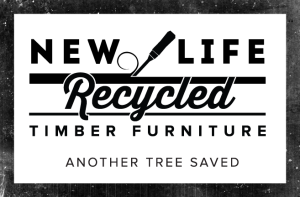After nearly forty years as a cabinetmaker and thirty three of those in the kitchen industry I thought it was time for a change. The idea of taking old timber that was destined for landfill and giving it a new life as a piece of furniture is very appealing to me. I have worked with a number of builders over the years that like the idea that the demolition timber from their job sites is reused and not dumped.
The Process
Materials
Timber is sourced from building sites, demolition yards and even skip bins. This is taken back to the workshop where it goes through the process of having any nails, screws, bolts or brackets removed. All this metal is recycled so it can start a new life and live on. The timber is then sorted into size and where possible species and colour. When an orders is placed, timber is selected keeping in mind features such as grain, colour, nails and bolt holes. The timber is than dressed to the required sizes and ready for construction.
Construction
There is a lot of furniture made today with price in mind. The down side of working to keep prices down cam be quality suffers. Together with our small workshop and low overheads we are able to spend time making our furniture using traditional forms of construction.
One of the most common joints used in our furniture is the Mortis & Tenon joint, and is used for its high strength. This joint is used in joining a rail to a leg, and comes in a number of forms such as a Stub Tenon or a Through Tenon.
When constructing drawers we prefer to use Dovetail joints, they are not only strong but also give a decorative finish.
Finishing
In keeping with our ECO theme the finish we apply to our furniture is important. We use and recommend Treatex Hard Wax Oil. This product based on three natural oils and three natural waxes, very durable and with very good water repelling qualities. It has a low odour and can be recoated by the home owner simply using a roller or paint brush.
